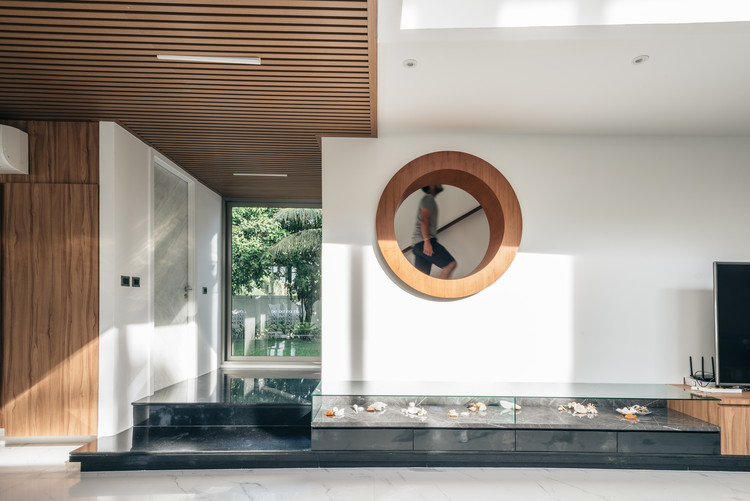Dar HI MATALI CRASSET
2012-02-23 00:00
“Dar HI不是一家酒店,也不是一家经典的SPA酒店,而是一个你可以在巴黎和沙漠中部几个小时车程内体验撤退并从精神疗法中受益的地方。”-Patrick Elouarghi
“Dar HI is not a hotel nor a classical SPA but more a place where you can experience withdrawal and benefit from a spiritual thalassotherapy a few hours away from Paris and in the middle of the desert”. -Patrick Elouarghi
经过在尼斯的HI酒店的经验,现在的达赫伊在内富塔,这是合作的成果,马塔利克拉塞特,帕特里克埃卢阿吉和菲利普查佩莱与一个新的概念生态退却。马塔利从沙地上站起一个城堡,致力于幸福。在周围的墙壁的保护下,你会发现高耸的房屋构成了一个小村庄。建筑的总体目标是在与自然遗址和当地生活相协调的同时,给出一个强有力的主张。Dar HI的主要颜色是矿石和沙子,在私人或公共区域、游泳池、餐厅和水疗中心都有全面的身体和精神护理选择。
After the experience of the HI hotel in Nice, now Dar HI in Nefta which is the fruit of the collaboration between matali crasset, Patrick Elouarghi and Philippe Chapelet with a new concept of eco-retreat. Matali literally rose a citadel, from the sand, dedicated to well being. Protected by surroundings walls you find a composition of elevated houses that constitute the Dar HI as a small village. The overall architectural goal was to give a strong proposition while in harmony with the natural site and the local life. Dar HI’s main colours are ochre and sand with a comprehensive choice of body and spirit care within areas that are private or communal, a pool, a restaurant and a Spa.
要进入达赫尔岛,你要向它走去,这是你停留的开始。汽车已被留在离房子更远的地方了。一扇谨慎的门会让你想象你走进一所私人住宅。入口、走廊、坡道是你在外部留下“密码”的最后一站。你脱下鞋子,穿婴儿服(突尼斯拖鞋)。你在家。正如你在传统的基础上所发现的,Dar HI是一个停留时间较长的房子,与短期旅游相反。这些地区的组织倾向于不同的可能性,要么与其他人分享片刻,要么在一个安静、退休的地方休息。客人们可以随心所欲地做他们想做的事。
To access the Dar HI you walk towards it and this is the beginning of your stay. The car has been left further from the house. A discreet door leads you to imagine that you walk in a private house. The entrance, a corridor, a ramp is the last stop where you leave your “codes” at the exterior. You take off your shoes and wear babouches (Tunisian slippers). You are at home. As you can find in the traditional foundouks, Dar HI is a house in which the stays are prolonged, at the opposite of short stay tourism. The organisation of the areas favours the different possibilities to either share moment with other people or to be in a calm retired place to rest. The guests can do as they please according to their wish.
3场地类型“我已经设想了一个建筑,是面向室内时,当你在外面和室外时,你在里面,爆炸代码”解释说。马塔利·克拉塞特设计了3种不同的区域:药丸屋、滑梯和沙丘。每一种可能性都与网站和酒店生活(室内露台、游泳池、Hammam…)有互动关系。还有它的客人。药丸屋-这些房子有着与众不同的景观-都是不同的。有些人可以俯瞰咸水湖的地平线,另一些人则可以看到棕榈树林及其非常多样的景观。在地面的高处,房间被构造成一个弓形窗户,仿佛整个房间都是完整的。一张小桌子,用来咬人或工作,一张大床,里面藏着淋浴和厕所,构成了房间。下面就像一个小村庄广场。每个人都有一个免受阳光照射的空间。广场、酒吧、水点和小喷泉都是很容易聚在一起的地方。
3 sites typologies “I have conceived an architecture that is towards the indoor when outside and towards the outdoor when you’re inside, exploding the codes” explains Matali. Matali Crasset designed 3 different areas : the pill houses, the troglodytes and the dunes. Each possibility has interaction with the site and hotel life (interior terrace, pool, hammam…) and its guests. The pill houses These houses have exceptional views that are all different. Some have a panorama overlooking the horizon of the salted lake, others have a view of the palm grove and its very diverse landscape. High above the ground the room is structured around a bow window, as if the view was itegrated in the room. A small table to nibble or work, a large bed that hides part of the shower and toilets compose the room. Down below it is like a small village square. Everyone has a space that is protected from the sun. The square, the bar, the water point and small fountains are all places to be easily together.
有三个被称为“小砖块”的地区完全独立于他们自己的私人露台,但也由一个圆形的区域从一个到另一个连接在一起。集体生活围绕着一个小广场,有一个小水串和一个面包烤箱。这些房间完全可以租给朋友或家人住。新鲜感让人想起了马特马塔典型的长统型住宅。这三个被称为沙丘的区域处于沙质水平。它们就像被风吹过的空地。它的灵感来自宿营地,它允许你根据自己的意愿调整你的舒适度。生活在沙丘中的经历,创造出你自己的巢穴,让你感觉离沙漠更近。它们都是不同的,一种是带有天然光线和室内花园的圆木,另一种是非常宽敞的室外露台和一扇大窗户,可以看到涅夫塔,第三扇也非常宽敞和清新。它提供了一个独立的房间和一个凉亭木制露台的日期树林的景观。
Three areas called troglodytes with small bricks from Nefta are completely independent with their own private terraces but also linked together by a circular area from one to the other. Collective life is articulated around a small square with a small water cascade and a bread oven. These rooms can be rented entirely for a stay with friends or family. The freshness reminds of the typical troglodytes houses of Matmata. The three areas called dunes are at sand level. They are like open spaces that the wind would have sculpted. The inspiration was the bivouac that allows you to modulate your comfort as you wish. The experience of living within the dunes creating your own nest to feel closer to the desert. They are all different, one has a loggia with a natural light and an indoor garden, the other very spacious has an external terrace and a large window with a view of Nefta, the third one also very spacious and fresh. It offers a view on the date grove with an independent room and an alcove wooden terrace.
与当地生活相协调,达赫伊暴露在西南面,俯瞰涅夫塔盆地。Dar HI拥有全城最好的全景。首先你会看到这座历史悠久的小镇,再往前看一点,你会看到枣林和地平线上的乔特-德杰里(古老的咸水湖),那里有美丽的日落。Dar HI自然融入了Nefta的景观、节奏和自然。帕特里克、菲利普和马塔利最初想要在村子里设想一座房子,以其活力和精神在该镇的中心地带。他们从来不认为自己与当地生活隔绝,相反,他们希望他们的项目能在城镇的行动和发展中发挥作用。那时,该项目逐渐转向可持续发展项目。
In harmony with local life Dar HI is exposed south west and overlooks the Nefta basin. Dar HI has the best panorama in town. First you see the historical town, a bit further you see the date grove and in the horizon the Chott-El-Djerid (old salted lake) with beautiful sunsets. Dar HI is naturally integrated in Nefta’s landscape, rhythm and nature. Patrick, Philippe and Matali wanted at first to conceive a house within the village to be in the heart of the town with its energy and spirit. They never considered to be isolated from local life on he contrary they wished their project to in the action and development of the town. That is when the project drifted towards a sustainable development project.
从达赫伊的第一幅画开始,马塔利研究了一种将当代材料与当地工艺品相结合的方法。设计师与当地工匠一起工作,考虑到他们的技术和制约因素。她观察了他们的建造技术,使用的梁和砖块,她使用的药丸房。在墙壁上,她选择了用Nefta制作的小粘土砖。棕榈树也在DAR HI的建筑和设计元素中被转换和重新诠释。排水沟和凹槽是当地建筑参考的提醒。马塔利用日常生活中的一些物品突出了草席和灯笼,比如在风中飘浮的地毯,现在是达赫伊的象征。
From the first drawings of Dar HI, matali researched a way to combine contemporary materials to local artefacts. The designer worked with local craftsman taking into account their techniques and constraints. She observed their construction technique using beams and bricks that she used in the pill houses. For the walls she chose small clay bricks that are made in Nefta. The palm tree is also transformed and reinterpreted in elements of the architecture and design within Dar HI. The gutter and recesses are reminders of the local architecture reference. The straw mattresses and the lanterns were highlighted by matali with some objects from everyday life like the carpet that floats in the wind, now the symbol of Dar HI.
位于突尼斯南部沙漠生态和可持续发展的生态小屋是Dar HI项目的基础。枣园是当地的珍宝,环境脆弱,必须加以保护和翻新。翻修工作始于阿尔伯特·德摩纳哥基金会资助的一项重大发展。DAR HI致力于绿洲的同一保存和发展。一个研究实验室将在DAR HI找到使用棕榈树和枣的新方法和技术。在绿洲内有一个阴影掩蔽处,一个最不舒适的木屋,一个植物园,其中一个将被精心挑选,将种植什么样的物种。绿洲和菜园将由Dar HI使用。因此,在沙漠中,供水问题是决定性的。到达Nefta的水来自温暖的水源,为Hammam和游泳池提供了Dar HI。这种水也存在于药丸屋周围的小沟渠中,可以灌溉绿洲。通过v2com发布材料
An eco lodge in the south Tunisian desert Ecology and sustainable development are the foundations of Dar HI’s project. The date grove is a local gem, in a fragile environment that has to be preserved and renovated. The renovation has started with a great development financed by the Albert de Monaco Foundation. Dar HI is committed in the same preservation and development of the oasis. A research laboratory will be in Dar HI to find news ways and techniques to use the palm tree and the dates. Within the oasis there is a shadowed shelter, a log cabin with minimal comfort, a vegetable garden in which a will be selected carefully what type of species will be grown. The oasis and the vegetable garden will be used by Dar HI. Being in the desert, the question of water supply is therefore decisive. The water arriving In Nefta comes from a warm source and supplies Dar HI for the hammam and the pool. This water is also present in small ditches around the pill houses and allows the irrigation of the oasis. Publication material via v2com
 举报
举报
别默默的看了,快登录帮我评论一下吧!:)
注册
登录
更多评论
相关文章
-

描边风设计中,最容易犯的8种问题分析
2018年走过了四分之一,LOGO设计趋势也清晰了LOGO设计
-

描边风设计中,最容易犯的8种问题分析
2018年走过了四分之一,LOGO设计趋势也清晰了LOGO设计
-

描边风设计中,最容易犯的8种问题分析
2018年走过了四分之一,LOGO设计趋势也清晰了LOGO设计


























































































































